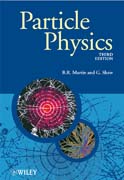
The modern theory of particle physics is known as the standard model and explains particle physics in terms of the interactions of these particles. An essential introduction to the subject, Particle Physics, Third Edition carefully develops the standard model of particle physics while emphasizing the interpretation of experimental data in terms of the basic properties of quarks and leptons. Developed for physics and astronomy undergraduates, this accessible and carefully structured Third Edition includes new sections on neutrino physics aswell as expanded coverage of detectors, including the LHC detector. INDICE: CONTENTS Suggested First Course Editors Preface to the Manchester Physics Series Authors Preface Notes 1. SOME BASIC CONCEPTS 1.1 Introduction 1.2 Antiparticles 1.3 Interactions and Feynman Diagrams 1.4 Particle Exchange 1.5 Units and Dimensions PROBLEMS 1 2. LEPTONS AND THE WEAK INTERACTION 2.1 Lepton Multiplets and Lepton Numbers 2.2 Leptonic Weak Interactions 2.3 Neutrino Masses and Neutrino Mixing PROBLEMS 2 3. QUARKS AND HADRONS 3.1 Quarks 3.2 General Properties of Hadrons 3.3 Pions and Nucleons 3.4 Strange Particles, Charmand Bottom 3.5 Short-Lived Hadrons 3.6 Allowed Quantum Numbers and Exotics PROBLEMS 3 4. EXPERIMENTAL METHODS 4.1 Overview 4.2 Accelerators and Beams 4.3 Particle Interactions with Matter 4.4 Particle Detectors 4.5 Detector Systems and Experiments PROBLEMS 4 5. SPACE-TIME SYMMETRIES 5.1 Translational Invariance 5.2 Rotational Invariance 5.3 Parity 5.4 Charge Conjugation 5.5 Positronium 5.6 Time Reversal PROBLEMS 5 6. THE QUARK MODEL 6.1 Isospin Symmetry 6.2 The Lightest Hadrons 6.3 Colour 6.4 Charmonium and Bottomium PROBLEMS 6 7. QCD, JETS AND GLUONS 7.1 Quantum Chromodynamics 7.2 Electron-Positron Annihilation 7.3Elastic Electron Scattering: The Size of the Proton 7.4 Inelastic Electron and Muon scattering 7.5 Inelastic Neutrino Scattering PROBLEMS 7 8. WEAK INTERACTIONS: QUARKS AND LEPTONS 8.1 Charged Current Reactions 8.2 The Third Generation PROBLEMS 8 9. WEAK INTERACTIONS: ELECTROWEAK UNIFICATION 9.1 Neutral Currents and the Unified Theory 9.2 Gauge Invariance and the Higgs Boson PROBLEMS 9 10. DISCRETE SYMMETRIES: C, P, CP AND CPT 10.1 P-Violation, C-Violation and CP-Conservation 10.2 CP Violation 10.3 Flavour Oscillations and the CPT Theorem 10.4 CP-Violation in the Standard Model PROBLEMS 10 11. BEYOND THE STANDARD MODEL 11.1 Grand Unification 11.2 Supersymmetry 11.3 Strings and Things 11.4 Particle Cosmology 11.5 Neutrino Astronomy 11.6 Dirac or Majorana Neutrinos? PROBLEMS 11 A. RELATIVISTIC KINEMATICS A.1 The Lorentz Transformation for Energy and Momentum A.2 The Invariant Mass A.3 Transformation of the Scattering Angle PROBLEMS A B. AMPLITUDES AND CROSS-SECTIONS B.1 Rates and Cross-Sections B.2 The Total Cross-Section B.3 Differential Cross-Sections B.4 The Scattering Amplitude B.5 The Breit-Wigner Formula B.5.1 Decay distributions B.5.2 Resonant cross-sections PROBLEMS B C. THE ISOSPIN FORMALISM C.1 Isospin Operator C.2 Isospin States C.3 Isospin Multiplets C3.1 Hadron states C.4 Branching Ratios C.5 Spin States PROBLEMS C D. GAUGE THEORIES D.1 Electromagnetic Interactions D.2 Gauge Transformations D.3 Gauge Invariance and the Photon Mass D.4 The Gauge Principle D.5 The Higgs Mechanism D.6 Quantum Chromodynamics D.7 Electroweak Interactions PROBLEMS D E. TABLES OF PARTICLE PROPERTIES F. SOLUTIONS TO PROBLEMS References Index Physical Constants and Conversation Factors
- ISBN: 978-0-470-03294-7
- Editorial: John Wiley & Sons
- Encuadernacion: Rústica
- Páginas: 464
- Fecha Publicación: 24/10/2008
- Nº Volúmenes: 1
- Idioma: Inglés
